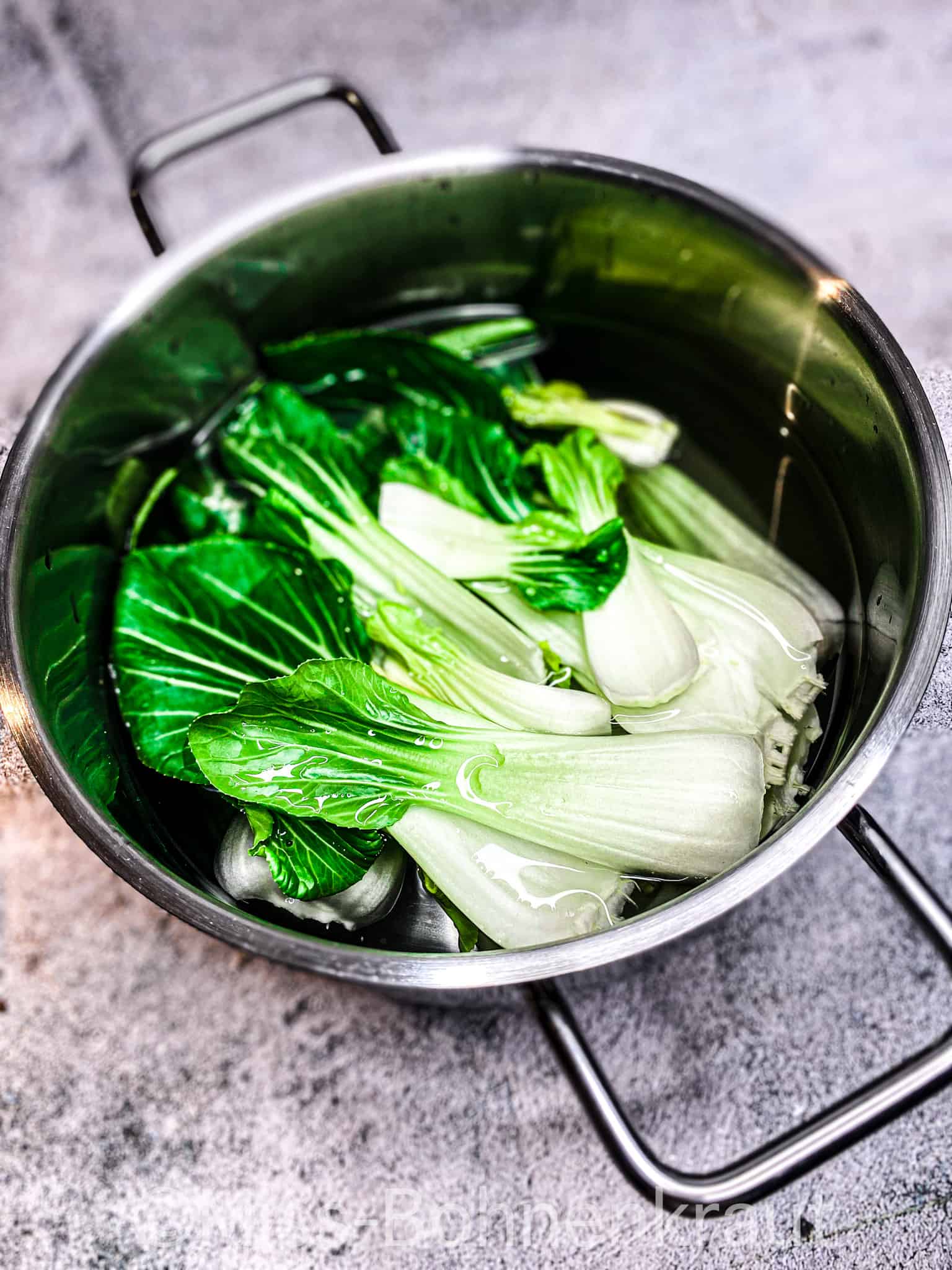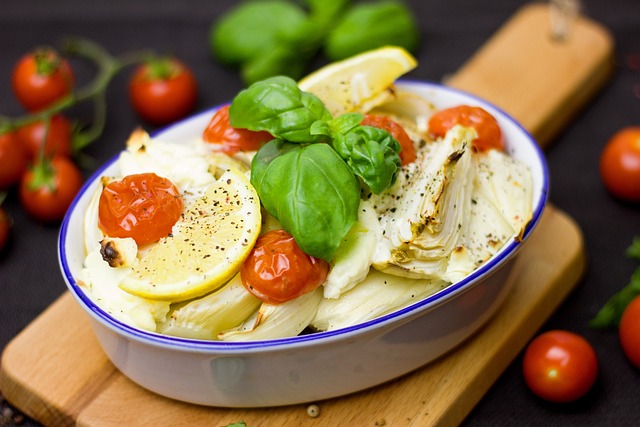The crisp, tender cabbage of Asian cuisine tastes incredibly good with this garlic-ginger sauce. This is super easy to make and incredibly quick! Try it!
Pak Choi and its history
Chinese cuisine is trendy. Precisely because of the wide range of vegan or vegetarian recipes, the exciting spiciness in the undertone of almost every dish and the variety of vegetables, more and more Europeans are discovering the Asian world of pleasure for themselves.
As a result, the vegetables native to the Asian region are also becoming better known. One of the vegetable world’s top exports is pak choi, a simple but versatile cabbage for dishes ranging from the simple to the highly sophisticated.
It is so popular above all because its preparation is quick and easy even for beginners and fits into almost every dietary preference!
What is bok choy?
Pak Choi is a type of cabbage originally from China. The name derives from the Cantonese word for the crunchy vegetable, in German it means Chinese mustard cabbage or kale. It is not only grown as a food, but also used in traditional Chinese medicine as a remedy that is said to ensure harmony and balance.
It consists of a woody, white stalk that gives way to large, green leaves. It looks similar to chard on the outside, to which there is no botanical relationship.
The healthy vegetable is often mistranslated as Chinese cabbage. Chinese cabbage is a distant relative of pak choi, but is a separate type of cabbage. Adding to the confusion is that Chinese uses the same character for bok choy and bok choy.
You can also find baby pak choi or Shanghai pak choi in the supermarket. However, these are not other subspecies, but describe the external appearance: baby pak choi have small heads and Shanghai pak choi have green petioles.
From China, Pak Choi quickly conquered Asian cuisine, because the cabbage grows extremely quickly and requires no special gardening skills. Therefore, it is also found in many Japanese, Korean and Thai recipes.
In Europe, it is grown in greenhouses because it thrives best in warm, humid climates. Only in Spain does it get warm enough for it to grow in the fields there. The season runs from May to October.
The vegetables are extremely healthy: they have very few calories but are a real vitamin bomb. Above all, it brings beta-carotene and vitamin K1 in abundance.
Caution: Vitamin K1 plays a major role in blood clotting. Therefore, if you are taking anticoagulants prescribed by a doctor, you may need to be careful when consuming large amounts of pak choi!
Although the study suggests that only the intake of vitamin K1 via supplements is problematic, but not vitamin-rich foods, you should still discuss your diet with your doctor.
Pak choi is otherwise great for various forms of nutrition. The low carbohydrate content makes it a standard food for low carb or keto, but it is also very low in fructose and therefore usually easily digestible for people with fructose intolerance.
It is also one of the few types of cabbage that does not cause flatulence. Anyone who has ever tried a cabbage soup diet will appreciate it!


How do you process pak choi?
Pak Choi is an all-rounder: you can serve it fresh as a salad, boil it, steam it, roast it and whatever else you can think of. The taste is slightly mustard-like and therefore gives dishes a special spiciness and spiciness.
The similarity to chard is not only external: Pak Choi can replace chard 1:1 because it also has very similar cooking properties. The same goes for spinach.
You prepare it as follows:
- Remove outer leaves generously
- Cut off the stalk
- wash each leaf thoroughly
- Separate the stems and leaves at the color overflow
- Cut the stems into small pieces, cut the leaves into strips
Asia meets German cuisine: You can also leave the leaves whole and use them as roulade wraps. And if you want to try something new, cook and serve the stalks like asparagus.
Blanching pak choi
In order to preserve the rich vitamins, it is advisable to cook them as gently as possible. It is therefore recommended that pak choi be blanched rather than cooked.
Blanching is a process of preparing food. The object in question is briefly exposed to high heat and then suddenly cooled to stop the cooking process. The name comes from the French blanche (dt: white), because meat gets a white color when blanched.
For the pak choi, boil water in a large pot. Let the leaves cook in the boiling water for 2 minutes, then plunge them into the ice water provided. The stalks take 4 minutes.
Prepare pak choi in a wok
Make sure you’re working with oil that can handle high heat. This is, for example, peanut oil, which is an integral part of Asian cuisine anyway.
First you fry the styles for about 4 minutes, then you add the leaves for another 2 minutes. The short time ensures that the pak choi remains crisp and al dente.
Then season and salt.
Pak choi steaming
Briefly sear the chopped stalks and then reduce the heat to medium-high. Add the leaves, 2-3 tablespoons of water and spices and bring to the boil, turning frequently. Then cover and let the pot simmer for 8 minutes.
If the dish tolerates it, you can also postpone steaming until the end of cooking: add the stems and leaves to the dish at the same time and let it steam, covered, for 10 minutes.
Read more about vegan recipes: VEGETARIAN VEGAN RECIPES
Pak Choi Steam Cooking
Steaming or steaming is similar to stewing but uses the hot water vapor to heat. It is therefore essential that the water level in the pot is low enough that the dish to be steamed does not come into contact with it. Common steamer attachments or special steamers are usually used.
The advantage is that aromas and nutrients are almost completely preserved. Some spice aromas are released particularly well and gently during steam cooking.
Vegetables are very suitable for steam cooking. Meat can also be steamed, but it usually takes several hours.
There are numerous methods of preparing pak choi on the Internet. If you want to learn more about it, have a look here , here and there .


Basic Recipe Steamed Pak Choi with Garlic Ginger Sauce
For 2-3 people you need:
- 750g pak choi
For the sauce:
- 2 spring onions
- 20 grams of ginger
- 3 cloves of garlic
- 2 dried chillies
- 3 tbsp peanut oil
- 1 tsp whole cane sugar
- 200ml of water
- a bit of salt
- some Sichuan peppers
- 3 tbsp soy sauce
- 1 tbsp balsamic vinegar
- 1 tsp cornstarch in 1 tbsp water
As an attachment:
- 200 g jasmine rice or brown rice
Proper preparation of pak choi in the basic recipe
Prepare rice:
- Wash the rice: In a bowl of cold, clear water, use your hands to swirl the uncooked rice in a circular motion. Pour off the milky water. Repeat process 2-3 until the water is barely cloudy.
Explanation: Washing the rice removes excess starch from the grains and frees it from environmental pollution and residual pesticide residues.
- Cook the rice using the water or swelling method, depending on your preference:
- Water Method: For 200g of rice, bring 1.2L of lightly salted water to a boil. Add the rice and let it boil briefly. Then reduce the heat and simmer uncovered for 15 minutes. Then pour off the water.
- Soaking method: Boil 200g of rice with 400ml of lightly salted water. Cover and cook for 15 minutes over low to medium heat until the rice has completely absorbed the water.
While the rice is cooking, you can use the time to prepare the sauce.
Prepare sauce:
- Remove the outer shell of the spring onions and cut off the root end. Separate at the color transition. Cut the white part into small rings, the green part into more generous pieces. Set aside some of the green rings for later decoration.
- Peel the ginger and cut into thin sticks or finely grate as you prefer. Peel and thinly slice the garlic, as well as the chili peppers.
- Add peanut oil to the already heated saucepan. Sauté onions, ginger, garlic, and chili over low-medium heat, stirring occasionally.
- Add the sugar, salt and Szechuan pepper and, after briefly sautéing, deglaze with the soy sauce, vinegar and water. Bring to the boil and season, then fold in the mixed cornstarch and allow the sauce to thicken over medium heat.
- Keep the sauce warm, stirring occasionally.
The main course:
- Wash the leaves of the pak choi thoroughly and leave them as large as possible. Bring water to a boil in a saucepan and cook the leaves in the steam attachment for 5 minutes.
- Remove the rice from the stove and arrange on plates. Garnish with the pak choi and add the sauce. Sprinkle with the remaining spring onions.
Defuse with pleasure
Like most Asian cuisines, Chinese cuisine likes to be spicy. The ginger, chili peppers and Szechuan pepper make the dish tingle deliciously on the tongue.
To reduce the sharpness, you can drink milk or yoghurt drinks with meals. The very spicy Indian cuisine, for example, swears by Lassis, a yoghurt-milk drink with fruit juice.
The latest studies show that it is not just the fat content that helps against the sharpness, as was previously assumed, but a specific protein in the milk. Therefore, you can use both whole milk and low-fat milk. Unfortunately, vegan milk alternatives rarely have the required fat content.
Toasted bread with mascarpone has proven to be the most effective – with a little sugar and some fruit, it makes a fantastic dessert!
If you don’t want to do without the taste of ginger and garlic, but do without the spiciness, a culinary break with the Asian idea of cooking also helps: Leave out the chili peppers and add a cup of crème fraîche to the sauce. This softens the effect, but unfortunately also changes the color of the sauce.
Other recipes with pak choi
Pak Choi goes well with many other sauces, both Chinese and crossover from other countries. You should definitely try a recipe with a sweet and sour sauce or white wine and cream garnish.
But even away from the stove, pak choi is a versatile vegetable:
Pak choy as a smoothie
Green smoothies are healthy and refreshing, especially in summer. Pak Choi is not for beginners in the field, as the mustard-like taste of a drink takes a lot of getting used to.
However, for experts, it is a great alternative to the commonly used spinach. It goes well with coconut water and ginger. Both sweet fruit and spices such as coriander, turmeric, nutmeg or chilli can be used as an additive.
I recommend the Pak Choi with cashew nuts or the Summer Pak Choi for a great recipe for Pak Choi as a smoothie. I have tested both recipes and can warmly recommend them to you.
Pak Choi as a salad
After washing and cutting, Pack Choi can be used directly as a green basis for a salad.
Any other type of vegetable goes well with this, from beans to zucchini, but also fruit such as apples, tomatoes or mangoes and nuts.
Staying with Chinese cuisine, you can add carrots, bean sprouts, ginger, peppers and mushrooms. Fish and seafood are more often included in salads in China than meat, but chicken also makes a good addition.
Oil or mayonnaise is recommended as a dressing.
There are also various delicious recipes for Pak Choi with salad. Try the pak choi – salad with tomatoes, spring onions and pepperoni or with vegetables that are in the fridge .
Pak choy as pesto
Pak choi also spices up noodles with Thai basil, pepperoni and lots of garlic. The deep green color is an additional highlight – after all, it’s a feast for the eyes.
But also with coriander, wild garlic, mushrooms or mint, a bright, strong-tasting pesto mix, which is perfect for refreshment on a hot summer’s day.
Shelf life of pak choi
Since bok choy has a high moisture level, it should be processed fresh when its leaves are bright green and the stalks have not yet yellowed or browned.
You can still store it in the fridge for up to a week. To keep the moisture as good as possible, you should wrap it in a damp cloth and store it in the crisper.
It is only suitable for freezing if it has been blanched before hand. Then you can leave it in the freezer for up to 9 months and take it out if necessary and gently thaw it overnight in the fridge.
However, even then it does not come close to the crunchiness and taste of a fresh Pak Choi.
Check out the link below if you want to learn more about caring for, planting and harvesting cabbages .

Steamed Pak Choi with Garlic Ginger Sauce
Equipment
Ingredients
2 spring onions
20 grams of ginger
3 cloves of garlic
2 dried chillies
4 tbsp peanut oil
3/4 tsp sugar or Xucker
1/2 tsp salt
1/2 tsp pepper
3 tbsp soy sauce
1 tbsp vinegar or balsamic vinegar
1 tsp cornstarch mixed in 1 tbsp cold water
750 g pak choi
2 tbsp sesame
Instructions
Cut the spring onions into rings, also cut the ginger into fine strips and cut the garlic and chili peppers into thin slices. If you don't have chillies, you can also use chilli powder.
Now heat the peanut oil in a saucepan. Then add the onion, ginger, garlic and chili and sauté everything at a low temperature for about 5 minutes. Make sure you stir from time to time.
Then season the Xucker or (sugar), salt and pepper and fry everything for about 2 minutes. Then briefly deglaze with soy sauce, vinegar and 200 ml water. At the end, everything is briefly boiled up and the cornstarch is stirred in.
Now the pak choi is prepared. Here the individual leaves are divided and steamed in a pot with water. You can also use a pot with a steamer attachment here. In total, the Pak Choi should be steamed for about 5 minutes.
Finally, the pak choi is served on plates. The sauce is boiled up briefly and then poured over the pak choi. We use sesame as a topping. This dish tastes great with rice or Asian noodles. Bon appetit!
Notes
Did you like the Pak Choi recipe ?
I am really happy about your feedback on the Pak Choi recipe here in the comments. Be sure to tag me on Instagram with your cooked pictures. I’m really happy about that! I would always like to know how you succeeded with my recipe and how you liked it.
You are also welcome to save my recipe pictures on Pinterest and use them later or even repin them.
Are you still interested in more salad recipes? Try the tomato onion salad or the mixed salad with fresh herbs !










